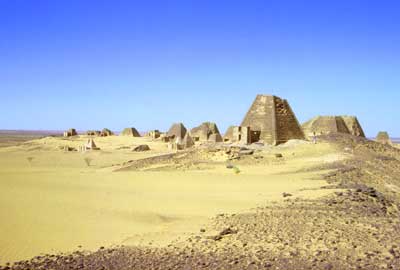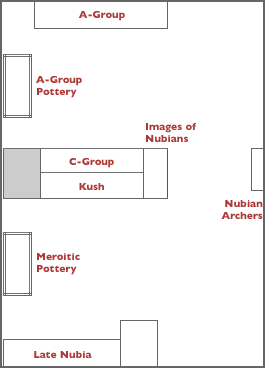Nubia was home to some of Africa’s earliest kingdoms.
Known for rich deposits of gold, Nubia was also the gateway through which luxury products like incense, ivory, and ebony traveled from their source in sub-Saharan Africa to the civilizations of Egypt and the Mediterranean.
Archers of exceptional skill provided the military strength for Nubian rulers. Kings of Nubia ultimately conquered and ruled Egypt for about a century.
Monuments still stand—in modern Egypt and Sudan—at the sites where Nubian rulers built cities, temples, and royal pyramids.

Nubians lived in the central Nile valley
African people from what is now the Sahara began to move toward the Nile in Nubia by around 5000 BC. They brought with them the art of making pottery. Originally herdsmen and hunters of large animals, they eventually became fishermen and farmers. Over time, new people moved into the region from the south, so that Nubia’s population was often a diverse mix of African peoples.
The river was a lifeline
Many Nubians lived along the Nile which curved northward through the desert. Farmers grew grains, peas, lentils, dates, and possibly melons. But especially important were their herds of cattle, a measure of wealth and social status. In the deserts, Nubians mined carnelian and gold, as well as other mineral resources. Bartering cattle, gold, carnelian, ivory, animal skins, hardwood, incense, and dates, Nubians traded with the Egyptians, their neighbors to the north, for grain, vegetable oils, wine, beer, linen, and other manufactured goods.
Archaeology and history reveal Nubia
Most information about ancient Nubia comes from archaeological excavation and from the study of monuments and rock art found there. But the art and writing of Nubians and of peoples contemporary with them also give important evidence. Records of ancient Egypt tell much about the history of Nubia, documenting a long and complex relationship between the two lands. Monuments and texts in the Egyptian language left by the Nubian kings, who became pharaohs of Egypt’s 25th Dynasty around 750 BC, also provide an extensive record. Nubians developed alphabetic writing systems around 200 BC during the Meroitic period. The Meroitic language is still not understood well enough to read more than words and phrases, but much documentation on Meroitic Nubia can be found in the art and literature of Greece and Rome, whose empires touched on the borders of Nubia after 330 BC.
The Names of Nubia
Nubia is a name that came into use in the Roman period
The origin of the name Nubia is obscure. Some have linked it to nwb, the ancient Egyptian word for gold. Others connect it with the term Noubades, the Greek name for people who moved into northern Nubia sometime in the 4th century AD.
Nubia was known as Kush for 2000 years
For much of antiquity, the region south of the 1st cataract of the Nile was called Kush. The name is known from ancient Egyptian, classical, and biblical texts. Whether it reflects an indigenous term is not known. The Kushites developed powerful kingdoms. The first was centered at Kerma (2000–1650 BC). The later kingdom had capitals at Napata (800–270 BC) and Meroe (270 BC–370 AD).
Some Nubian cultures are known by archaeological names
A-Group, C-Group, X-Group, and Kerma (the name of a modern town near the archaeological site of the early Kushite kingdom) are names archaeologists assigned to cultures they excavated in Nubia.
Nubia Gallery Floor Plan




